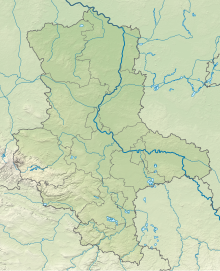Luppeaue near Horburg and Zweimen
Coordinates: 51 ° 22 ′ 4 " N , 12 ° 9 ′ 26" E
The Luppeaue near Horburg and Zweimen is a nature reserve in the city of Leuna and the municipality of Schkopau in the Saalekreis in Saxony-Anhalt .
The nature reserve with the registration number NSG 0197 is 378.9 hectares . It is to a large extent part of the FFH area “Elster-Luppe-Aue” and the EU bird sanctuary “Saale-Elster-Aue south of Halle”. The nature reserve is bordered to the northeast by the nature reserve " Elsteraue at Ermlitz " and is otherwise - up from short areas where it to Zweimen , Dölkau or Horburg-Maßlau borders - fully from the conservation area surrounded "Elster-Luppe-Aue". 48.4 hectares of the nature reserve are designated as a total reserve. The area has been under protection since 2002 (date of regulation: April 12, 2002). The responsible lower nature conservation authority is the Saalekreis.
The nature reserve is located between Halle (Saale) and Leipzig and is protecting a floodplain complex in the lowlands of the Luppe and Weißer Elster . The nature reserve in the landscape, which has been severely damaged by lignite mining in the Merseburg-Ost open-cast mine , is characterized by hardwood alluvial forests and moist oak-hornbeam forests. The meandering Luppe , which is still relatively near-natural, runs through the forest complex with numerous oxbow lakes , some of which are filled with water again due to the rise in groundwater after the lignite mining stopped.
The hardwood forests are primarily made up of oak and ash. Furthermore, here falter even remainders of the elm , which in other parts of Magpie Luppe- and Saale-Elster-Aue result of Dutch elm disease have disappeared. The oak trees in the nature reserve are sometimes very old. The herbaceous layer of the riparian forests is formed by numerous spring bloomers, including mass occurrences of wild garlic . The shrub layer is formed in addition to the young growth of the tree species typical of the site, including black elder , red dogwood and eccentric cones. The waters in the nature reserve are often accompanied by softwood bushes . The drier areas near Dölkau and Horburg are occupied by oak and hornbeam forests. Aquatic plant communities worthy of protection settle in the Luppe , especially those of the flooding buttercup .
In the north, south and west of the alluvial forest complex, species-rich wet meadows are preserved, which are formed as oat, foxtail, burnt-cone, grass clown, cabbage thistle and Silau meadows. Here z. B. Dyer Charter , Devil's , autumn crocus , Bistort , tuberous thistle , Rasensegge , Filzsegge , Ordinary focal umbel , gloss meadow rue and Carex distans . In addition, moist are high and banks Staudenfluren to find.
The reserve is the habitat a diverse Avifauna , including black and red kites , Buzzard , harrier , Schwarzspecht , means Specht , Spotted Crake , Kingfisher and Neuntöter . The barn owl breeds in Dölkau Castle in the immediate vicinity of the nature reserve. Even bats , including Daubenton's bat , Noctule and Big and Little Bart bat , are native in the nature reserve. Mammals are u. a. represented by ermine , weasel , brown hare and voles such as the short-eared mouse and shrews such as the field and pygmy shrew .
The waters in the nature reserve are home to many amphibians , including great crested newt , garlic and green toad , moor and grass frog and tree frog . The tree frog population is considered to be the basis for the repopulation of numerous bodies of water up to the Saale in the 1990s . Reptiles are represented by grass snakes and sand lizards . Furthermore, the waters are home to various snails , including belt-plate snails, ear mud snails and pointed marsh snails, as well as the clams, the great pond clam and the common pond clam .
The meadows , reed beds and tall herbaceous meadows are also home to grasshoppers that are adapted to damp locations, such as the short-winged sword insect and the great golden insect . A peculiarity is the common grasshopper, which otherwise only occurs in a few places in Saxony-Anhalt.
The nature reserve borders mainly on agricultural areas , in the south and east also on the rural districts of Leuna. The district road between Dölkau and Horburg-Maßlau runs through the nature reserve.


